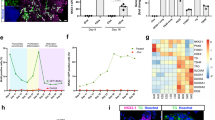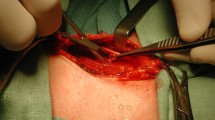Abstract
The aim of the present study was to develop atransplantation technique for restoration of thyroidfunction in rats with radioiodine-inducedhypothyroidism. Each Wistar rat received the dose of75.0 μCi of 131-iodine by intraperitonealinjection. The serum thyroxine and triiodothyroninevalues in all rats fell to low levels by 2.5 weeksafter radioiodine administration. Thexenotransplantation of 3-day-old newborn pig thyroidorgan culture was performed on day 18 afterradioactive ablation by injection into the fat tissueof anterior abdominal wall. Epithelial cell swarmswith follicular formation manifested themselves amongadipose tissue on day 7 as well as day 17 afterxenotransplantation. The serum thyroxine andtriiodothyronine values in the rats were generallywithin the euthyroid range by day 7–17 afterxenotransplantation. The thyroid gland of ratsreverted to the norm in morphofunctional appearance.These results indicated that the xenografted newbornpig thyroid organ culture allowed a restoration of thyroid function in Wistar rats with post-radioiodine hypothyroidism.
Similar content being viewed by others
References
Bauer MF and Herzog V (1988) Mini organ culture of thyroid tissue: a new technique for maintaining the structural and functional integrity of thyroid tissue in vitro. Lab Invest 59: 281–291.
Kitamura Y, Shimizu K, Nagahama M and Shoji T (1994) Cryopreservation of thyroid pieces-Optimal freezing condition and recovery. J Jpn Surg Soc 95: 14–20.
Lafferty KJ, Cooley MA, Woolnough J and Walker KZ (1975) Thyroid allograft immunogenicity is reduced after a period in organ culture. Science 188: 259–261.
Pasteur IP, Tronko ND, Drozdovich II, Turchin IS and Balla IA (1999) Thyroid transplantation: possibility of application for the treatment of persistent hypothyroidism and study of mechanisms of interaction between graft and hypothalamic-pituitary axis of recipient. In: Y Kitagawa et al. (eds) Animal Cell Technology: Basic and Applied Aspects, Vol. 10 (pp. 289–293). Kluwer Academic Publishers, Dordrecht.
Pushkar NS, Makedonskaya VA, Utevsky AM, Chuiko VA, Karpenko LG and Tsarikovskaya NG (1984) Autoimplantation of cryopreserved (-196 °C) thyroid parenchyma as a treatment method for postoperative hypothyrosis. Problemy Endokrinologii (Moscow) 30: 42–46.
Shimizu K, Nagahama M, Kitamura Y, Igarashi T, Aida N and Tanaka S (1996) Improvement of thyroid function after autotransplantation of cryopreserved thyroid tissues in rats: clinical application of the procedure to patients with persistent hypothyroid Graves' disease after thyroidectomy. Thyroidol Clin Exp 8: 55–62.
Author information
Authors and Affiliations
Corresponding author
Rights and permissions
About this article
Cite this article
Pasteur, I., Tronko, N., Drozdovich, I. et al. Xenotransplantation of cultured newborn pig thyroid tissue for the treatment of post-radioiodine hypothyroidism in rats. Cytotechnology 33, 89–92 (2000). https://doi.org/10.1023/A:1008185701106
Issue Date:
DOI: https://doi.org/10.1023/A:1008185701106




